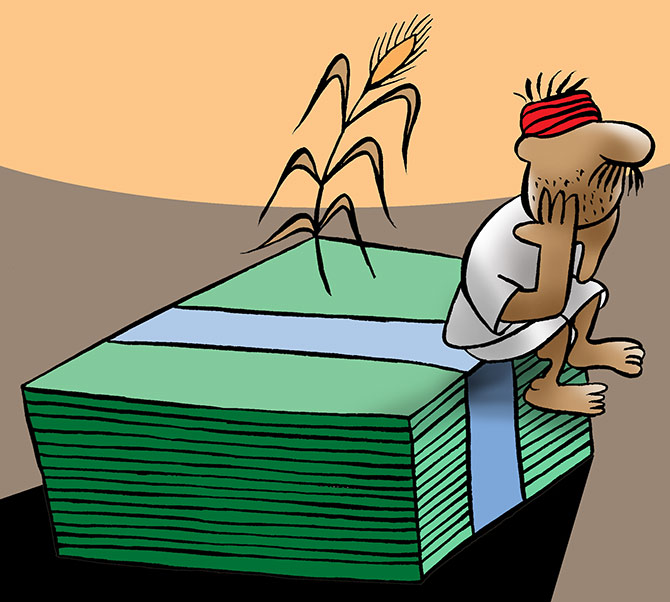A proposal to increase Minimum Support Price (MSP) is generally perceived as a farmer-friendly measure. This sounds like a reasonable proposition to alleviate farmers’ distress, given that it sets a floor price to ensure that the returns on the farm produce do not fall below a certain level. It acts as a ‘support’ since it gives an assured minimum price that the government promises to pay for the produce if no one else in the market offers to purchase above this price. Thus, it not only provides an assured market for the farmer, but it also protects the farmer from the price fluctuations and acts as a safety net.
Let’s move beyond its face value and analyse- is this the solution to farmers’ woes? The origin of the policy on MSP dates back to 1960s in the wake of the green revolution to guarantee price realization for the farmers. The Government of India announced the MSP on the recommendation of Commission for Agricultural Cost and Prices for cereals, pulses, oilseeds, cotton, jute, and tobacco. The idea was to complement MSP with procurement and public distribution system, and that is where the divergence between proposition and reality begins.
MSP is announced by the Government of India (GoI) for 24 crops every year. However, the procurement mechanism is functional only for 2-3 major crops, making this pricing policy effectively non-existent for other crops in the first place. Even for these crops, which have an established procurement mechanism in place, the infrastructure exists only in some states like Punjab and Haryana and is either absent or inefficient in states like Bihar, West Bengal, and the North Eastern states. Thus the benefits of MSP are out of reach for a majority of farmers and it does not exercise a lot of influence on the actual market price.
Poor infrastructure and lack of pricing policy for the majority of the crops cause a distortion in cropping patterns. Offering a higher MSP for some crops incentivizes the farmer to produce surplus quantities of those crops. Since the resources are limited in this zero-sum game of agriculture, there would be insufficient production of some other crops. The government’s general response to this irregularity is to set higher MSP for another set of crops and this rebound effect keeps occurring. For example, in the recent pulses’ crisis, in spite of the demand for pulses in the market, there was inadequate production and consequent supply due to the preference of farmers towards higher MSP crops like cereals. Ultimately, the government had to resort to imports to meet these demands. Consequently, MSPs were increased for pulses, following which market prices crashed below MSPs.
Since MSPs are not offered for fruits and vegetables, the focus shifts from horticulture production due to a lack of incentives. The trend of tilting towards some crops alone impacts genetic diversity in the long run. India ranking 103 out of 119 countries in the Global Hunger Index 2018 is a clear indicator of nutritional deficiency and the need for diversification of crops.
Another flaw in the MSP model is that the GoI determines MSP as a single price for the crops across the nation. In a country like India with diverse agro-climatic zones, this is determined as an average of prices across the states and does not address the regional variations of input costs of crop production. Hence it is not equally profitable to all the regions.
Ashok Gulati and Gayathri Mohan in their paper ‘Towards sustainable, productive and profitable agriculture:Case of Rice and Sugarcane’, point out that in spite of the farms in West Bengal and Bihar consuming 2-3 times less water than the farms in Punjab to produce the same quantity of rice, Punjab continues to grow paddy just because of government being an assured buyer and has good procurement operations. Similar is the case for sugarcane in Maharashtra with Fair and Remunerative Price. Therefore the policy hurts effective utilization of water resources, especially groundwater, eventually leading to unsustainable cropping patterns.
Despite its procurement commitments under MSP to protect the farmers and to maintain the buffer stocks, the government has failed to create a robust storage infrastructure. A case for better storage infrastructure is a whole other debate but look at it this way – the resources employed in producing the food grains rotting in government godowns could have been employed in a different crop grown as per demand in the market. Demand responsive supply could have fetched farmers remunerative prices or an imbalance thereof could have acted as a pointer to the farmer about lack of demand for that crop in the market, encouraging them to employ their resources on another crop in the next season.
Another noteworthy point about MSP is the lack of awareness among the farmers about its announcement. NITI Aayog’s Evaluation Report on Efficacy of MSPs points out that 81% of cultivators were aware of MSPs and out of them, only 10% knew about MSP before the sowing season. In states like Uttar Pradesh and Karnataka, none of the farmers knew about MSP before sowing season.
In the absence of all the above linkages in procurement, storage, and information dissemination, if we keep raising the MSPs above market prices, eventually private trade will recede since the government players like Cotton Corporation of India or NaFed lack the institutional capacity to meet the demands. Such artificial tinkering finally leads to market failure. The MSPs, which act as a trade-distorting measure, have been a major point of discord between India and other countries like the US and UK. Ashok Dalwai Committee Report on Doubling the Farmers Income suggests that the farmers would eventually gain better from a more robust system of procurement rather than an increase in MSPs. It also supports private participation in the procurement process.
Despite many such reports highlighting the inability of MSP in addressing agrarian distress and increasing the farmer’s income, the reason it keeps rising is that it is a powerful political tool. The perception that MSP benefits the farmers goes well with vote bank politics. In this context, it is noteworthy to mention the income support scheme for farmers- Rythu Bandhu by Telangana government. Under this scheme the farmers get a fixed per-acre subsidy irrespective of the crop, and the markets decide which crop is to be grown. Direct income support works more efficiently than MSP in ensuring good prices while not hampering the markets, and also works as an effective political tool as is evident in the results of Telangana elections. Maybe the time has come to shift to income support as evidence shows that this could be one of the rare policy solutions that make both economic and political sense.
Read more: https://spontaneousorder.in/its-not-1950-india-needs-an-urgent-policy-overhaul-in-agriculture/
Post Disclaimer
The opinions expressed in this essay are those of the authors. They do not purport to reflect the opinions or views of CCS.






